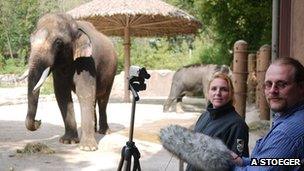Elephant mimics Korean with help of his trunk
- Published
Here Koshik interacts with his trainer and repeatedly says "choah", which means good
An Asian elephant called Koshik has astounded scientists with his Korean language skills.
Researchers report that the mammal has learnt to imitate human speech and can say five words in Korean: hello, no, sit down, lie down and good.
The zoo animal places the tip of his trunk into his mouth to transform his natural low rumble into a convincing impression of a human voice.
The study is published in the journal Current Biology.
Koshik's vocal abilities mean that elephants now join a growing list of animals that are able to mimic man, from parrots and mynah birds to more unusual animals such as sea lions or the recently reported case of a human-sounding beluga whale.
Meaningful conversation?
The study's lead author Dr Angela Stoeger, from the University of Vienna in Austria, said she first came across Koshik after videos of the elephant, who belongs to Everland Zoo in South Korea, were posted on YouTube.
After making contact with the zoo, she went to South Korea to record the animal so she could study its unusual vocal talent.
Dr Stoeger said: "We asked native Korean speakers, who had never experienced the elephant before, to write down what they understood when we played back recordings from Koshik.
"We found a high agreement of the overall meaning."
Here, Koshik's trainer says 'annyeong' or hello - followed by the elephant's impression
Dr Stoeger and her colleagues found that Koshik's calls correlated to five Korean words: "annyeong" (hello); "anja" (sit down); "aniya" (no); "nuwo" (lie down) and "choah" (good).
Here the trainer and Koshik say 'nuwo' (lie down)
In this recording, Koshik's trainer says 'anja' or sit down, and the elephant repeats this
"Human speech has two important aspects, one is pitch (how high or low a sound is) and one is timbre (the musical quality of a voice), and Koshik is matching both of these aspects," Dr Stoeger told the BBC.
Usually, elephants produce much deeper sounds, sometimes of such a low frequency that they are outside the range of human hearing, and these calls can boom many miles away.
While Koshik was capable of producing these more typical elephant noises, he needed the help of his trunk to morph these into something far more human. The researchers said this was behaviour they had not seen before.
"He always puts his trunk tip into his mouth and then modulates the oral chamber," explained Dr Stoeger.
"We don't have X-rays, so we don't really know what is going on inside his mouth, but he's invented a new way way of sound production to match his vocalisations with his human companions."
She added: "If you consider the huge size of the elephant and the long vocal tract and other anatomic difference - for example he has a trunk instead of lips... and a huge larynx - and he is really matching the voice pitch of his trainers, this is really remarkable."
But while Koshik sounds convincing, the researchers do not believe that he has any comprehension of the words that he is saying.
Instead, they think that the elephant took up talking as a way to bond with his human companions.
Between the ages of five and 12, Koshik was the only elephant at Everland Zoo, and the researchers said that this was a crucial period for elephant development.
Dr Stoeger explained: "Humans were his only social contact - and we believe Koshik is using these vocalisations as a function to strengthen the socials bonds with his companions, which are humans in this case."
Animal magic
Professor Klaus Zuberbuehler from the school of psychology and neuroscience at the University of St Andrews said that the findings were "enlightening".

Understanding how animals imitate sounds can help scientists to better understand human language
He told BBC News: "What's needed now, in my view, is field research with free-ranging animals to see if vocal imitation plays any role in the natural lives of elephants or if it's just a byproduct of human enculturation and socially abnormal upbringing."
Scientists say that understanding how and why some animals make sounds could help us to understand how speech evolved.
A limited but diverse number of species are capable of hearing a sound, copying it and then reproducing it. Understanding these vocal imitations could help to provide clues about the building blocks of language.
Prof Zuberbuehler added: "Vocal imitation... may be driven largely by specific social forces, such as the desire to bond with a specific other individual.
"It also makes me think that the evolution of vocal imitation may be more successfully investigated by comparing how different animal species use vocal behaviour to strengthen their social bonds, rather than by studying the anatomy and neurophysiology of vocal tracts."
- Published22 October 2012